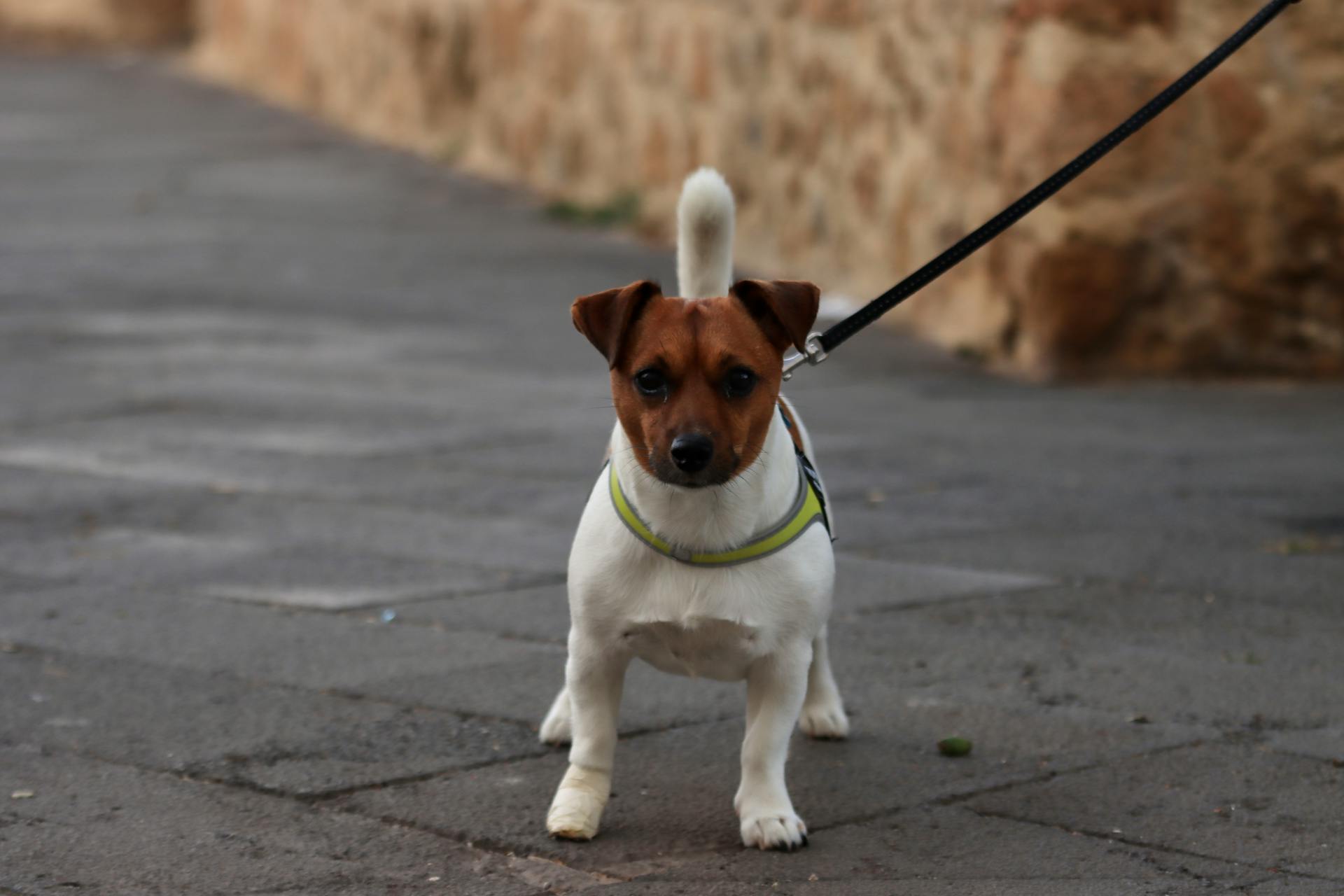
The Papillon Japanese Chin is a rare and adorable breed that's sure to capture your heart.
This breed is a cross between a Papillon and a Japanese Chin, and they're known for their gentle and affectionate nature.
They typically weigh between 4-11 pounds and stand between 8-11 inches tall, making them a perfect companion for apartment dwellers.
They require regular grooming to prevent matting and tangling of their long, silky coats.
Their lifespan is around 12-15 years, which is relatively long for a small breed.
They're highly intelligent and trainable, but they can be stubborn at times, so consistency and patience are key.
They thrive on attention and interaction, so they're best suited for families or individuals who can provide plenty of love and attention.
Quick Facts
The Japanese Chin is a breed with a rich history, and here are some quick facts about this adorable pup.
The Japanese Chin originated in China, not Japan, which is a common misconception.
This breed typically stands between 8 to 11 inches tall.
The Japanese Chin weighs in at around 4 to 7 pounds, making them a relatively small companion.
Their coat is long, silky, and straight, requiring regular grooming to prevent matting.
You can spot a Japanese Chin by their distinctive white coat with black or red markings.
They're known for their sweet, affectionate, and playful temperament, making them a great fit for families.
Their activity level is moderate, so they need regular exercise to stay happy and healthy.
On average, the Japanese Chin lives for 12 to 15 years, which is a significant commitment for any dog owner.
The Japanese Chin is part of the Toy Group, which includes other small and playful breeds.
Here are the key stats for the Japanese Chin at a glance:
Some notable individuals who've owned a Japanese Chin include Ozzy and Sharon Osbourne, as well as the late Joan Rivers.
History and Origins
The Japanese Chin is an ancient breed that originated in the Chinese imperial court, where it was highly prized and often given as a gift to emissaries from other lands. This noble background is still evident in the breed's aristocratic demeanor.
The Japanese Chin's journey to Japan is believed to have been as a gift to the emperor, which is how it got its name. In Japan, the breed was regarded as a separate being, not just a dog.
The breed's exact origins are still debated amongst historians, but it's widely recognized that the Japanese nobility nurtured the breed from perhaps as far back as 1,000 years ago. This long history has contributed to the breed's unique characteristics.
The Japanese Chin was first introduced to Western countries in the middle of the 19th century, when Japan began actively trading with other countries after over two centuries of self-imposed seclusion. They were often offered as gifts to naval officers or sold to visiting traders and sailors.
Take a look at this: Shiba Inu Price Japan
The breed was first recognized by the AKC in 1888, and is often also referred to as a Japanese Spaniel. This recognition helped to establish the breed's popularity in Great Britain and America.
The Japanese Chin is closely related to the Pekingese, another ancient breed from the same region. This shared ancestry is evident in their similar characteristics and features.
The breed's popularity declined in the 20th century, but it's still a beloved companion animal today. If you're looking to add a Japanese Chin to your family, you can find a reputable breeder on the AKC's website.
Breed Characteristics
The Japanese Chin is known for being even-tempered, loyal, and affectionate, making them a wonderful companion. They're also quite social and can suffer from separation anxiety if left alone for long periods.
Japanese Chins are intelligent dogs with a high level of intelligence, which makes them relatively easy to train. However, they can be a bit reserved with new people and pets, so introductions should be done carefully.
Here's a quick rundown of some key characteristics of the Japanese Chin breed:
Characteristics of the Papillon Japanese Chin
The Papillon Japanese Chin is a unique breed that exhibits several distinct characteristics. They are known for their small size, typically weighing between 4-11 pounds.
Their small stature makes them a great fit for apartment living, as they require minimal exercise to stay happy and healthy. They're perfect for city dwellers who want a low-maintenance companion.
Their friendly and outgoing personalities make them excellent family pets, as they get along well with children and other pets.
Temperament
The Japanese Chin is a breed that's known for being even-tempered and loyal. They're also quite affectionate and love to curl up on your lap.
One of the unique characteristics of the Japanese Chin is their ability to climb, which is often described as "cat-like." They're not afraid to perch themselves on high surfaces, just like a cat.
Japanese Chins are generally social and loyal companions, but they can be reserved with new people and pets. They require proper introductions and socialization to feel comfortable around others.
Consider reading: Which Dog Is the Most Loyal
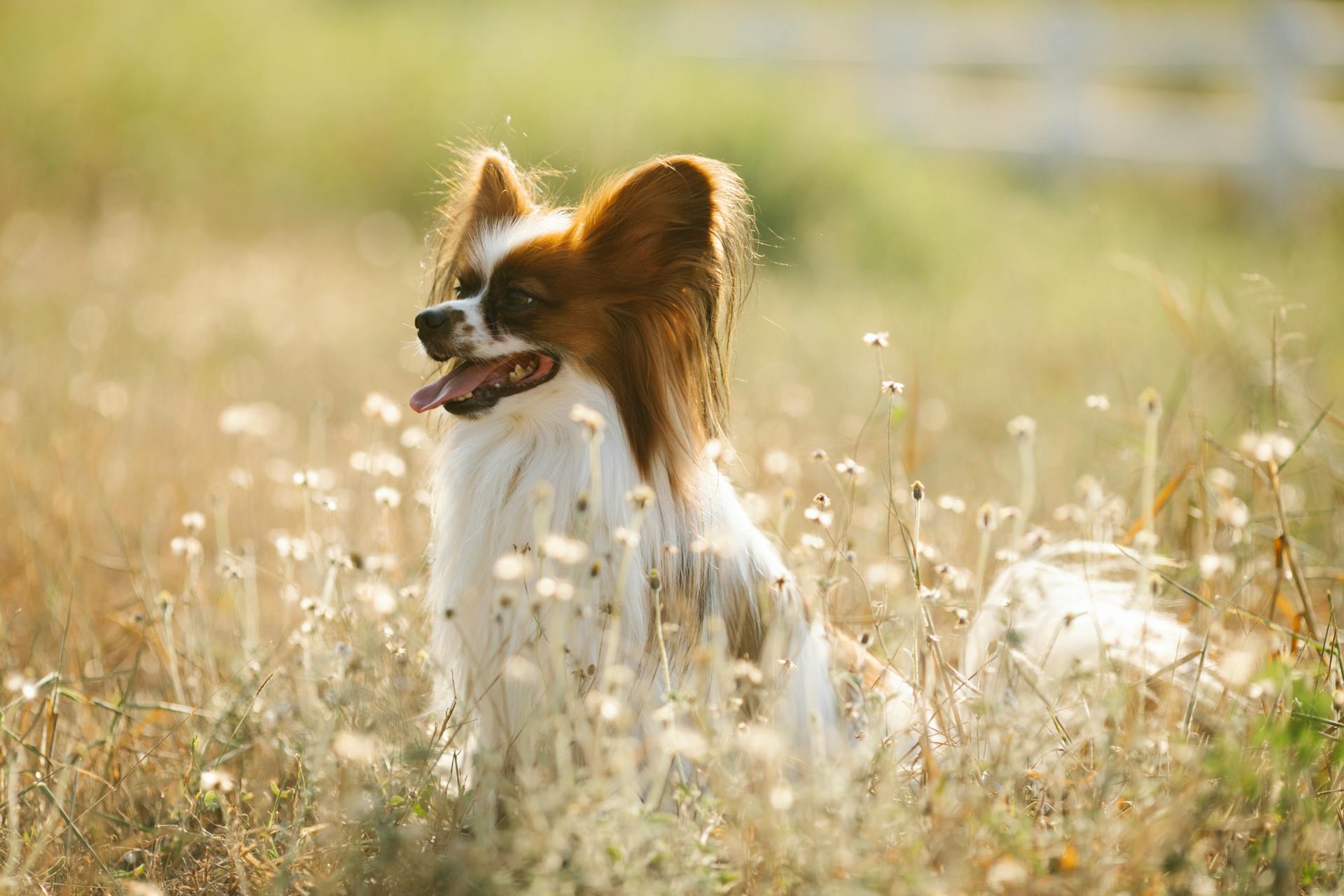
They're also known to suffer from separation anxiety if left alone for long periods. This means they need plenty of attention and interaction from their owners.
In terms of exercise needs, Japanese Chins require a moderate amount of physical activity to stay happy and healthy. A daily walk or playtime should suffice.
Here's a breakdown of the Japanese Chin's temperament traits:
Japanese Chins are also known for their independent streak and strong will, which can make training a bit challenging. However, with patience and consistency, they can learn to be well-behaved family members.
Size and Appearance
The Japanese Chin is a sturdy but refined breed, standing between 8 to 11 inches at the shoulder.
Their weight can vary significantly, ranging from 4 to 9 pounds.
These small dogs may be tiny, but they pack a big personality.
Japanese Size
The Japanese Chin is a compact breed, standing between 8 to 11 inches at the shoulder.
Their weight is surprisingly light, ranging from 4 to 9 pounds, making them a great companion for apartment dwellers.
Coat Color and Grooming
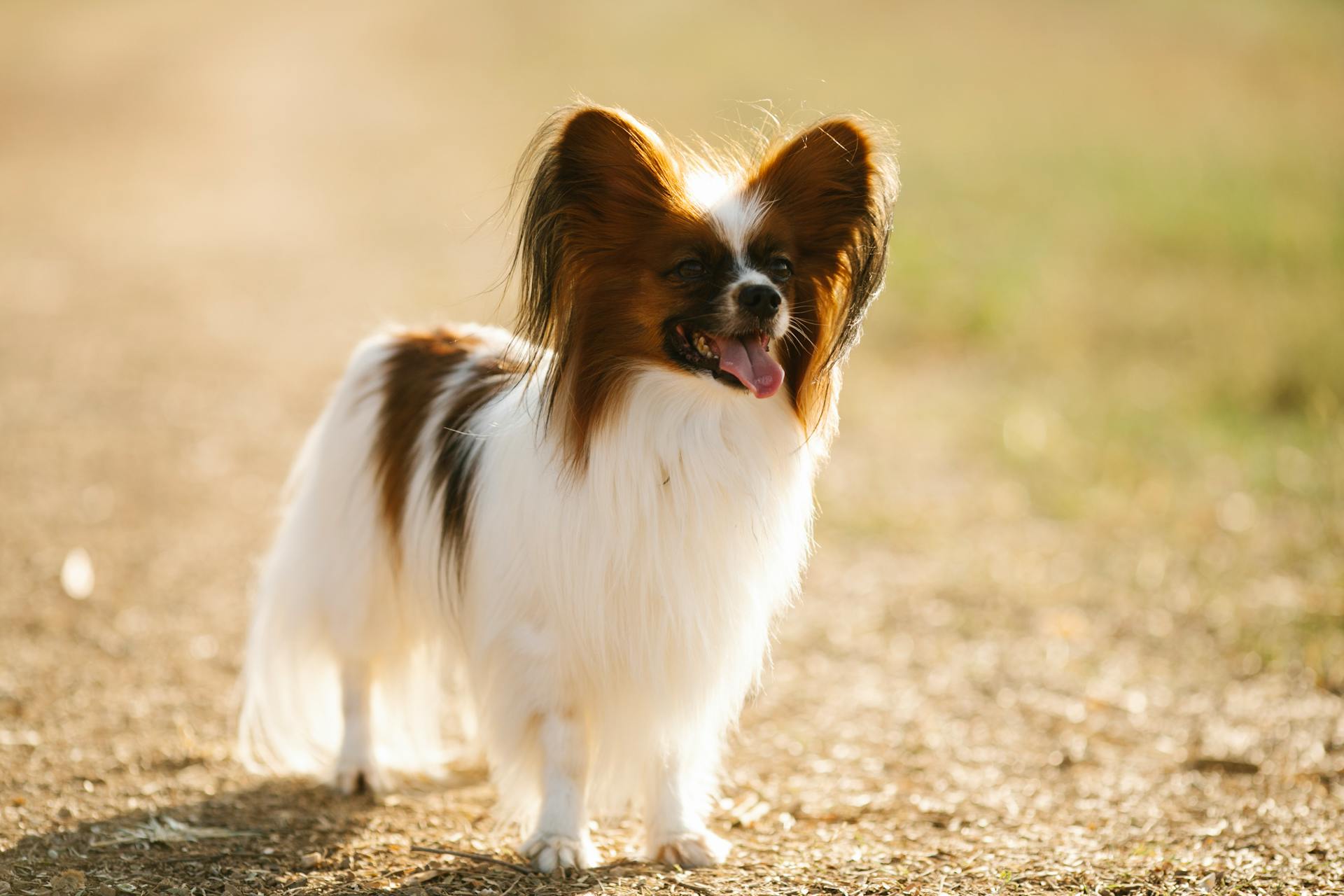
The Japanese Chin's coat is a beautiful feature of the breed, and it's silky to the touch. It's moderately long with a thick mane, feathered ears, a plumed tail, feathering on the back of the front legs, and light feathering that resembles culottes on the rear legs.
Japanese Chins come in three main coat color patterns: black and white, red and white, and black and white with tan points. You'll often see them with short hair on their head, face, and forelegs.
Regular grooming is essential to prevent matting and tangling, so weekly brushing is a must. Brushing also helps to keep their hair from flying around the house.
A weekly brush-out is recommended, especially during seasonal shedding. You can use a pin brush to gently brush their coat upward and outward.
Health and Care
The Japanese Chin is a relatively healthy breed, but like all breeds, they can be prone to certain health issues. They can suffer from heat intolerance, especially during exercise.
Their delicate neck requires special care when walking them, so it's best to use a harness instead of a collar. This will help prevent any potential injuries.
The Japanese Chin can be prone to a few congenital conditions, including luxating patella, ophthalmic problems, heart murmurs, epilepsy, GM2 gangliosidosis, and brachycephalic syndrome. These conditions can be inherited, so it's essential to work with a reputable breeder who has health-screened their parents.
To keep your Japanese Chin healthy, make sure they receive an appropriate amount of exercise. While they don't require a lot of physical activity, regular walks and play sessions are still necessary.
Here are some common health issues that can affect Japanese Chins:
- Luxating patella: This condition causes the dog's kneecaps to fall out of place.
- Ophthalmic problems: The breed may be prone to cataracts, dry eye (also known as keratoconjunctivitis sicca), entropion (when the eyelid can fold inwards), and corneal abrasions.
- Heart murmur: An early onset heart murmur, which is an abnormal sound in the heart, will typically be found during a puppy's wellness checkup.
- Epilepsy: A potential underlying abnormality, such as a brain tumor, may cause seizures.
- GM2 gangliosidosis: This condition is also known as Tay-Sachs disease. It is a neurological condition that can be fatal and has been known to affect the breed. DNA testing will ensure the disease would not be passed on.
- Brachycephalic syndrome: Because of the shape of their face, a Japanese chin can exhibit symptoms like snoring, noisy breathing, difficulty breathing, and exercise intolerance.
Their lifespan is typically around 10 to 12 years, but with proper care and attention to their health, many Japanese Chins live well into their teens.
Care and Maintenance
The Japanese Chin is a relatively low-maintenance breed, requiring only a daily walk or play session.
Their exercise needs are minimal, making them a great fit for apartment living. They're happy to spend their time lounging around with their favorite people.
To keep their coat looking silky and smooth, a weekly brush-out is recommended. You can use a pin brush to gently brush the coat upward and outward.
Their grooming routine is relatively simple, but regular attention is necessary to prevent matting and tangling. A monthly bath is sufficient, unless they get dirty.
Weekly brushing will help keep their hair from flying around the house, and daily brushing will prevent hair from tangling. Don't forget to trim their nails once or twice a month to prevent painful tears.
Regular ear checks are also important to prevent infections. Just wipe the outer ear with a cotton ball dampened with gentle ear cleaner.
A fresh viewpoint: When Will Shiba Inu Reach 1 Cent
Japanese Care
Japanese Chin require very little exercise, a daily walk or play session is enough to keep them happy.
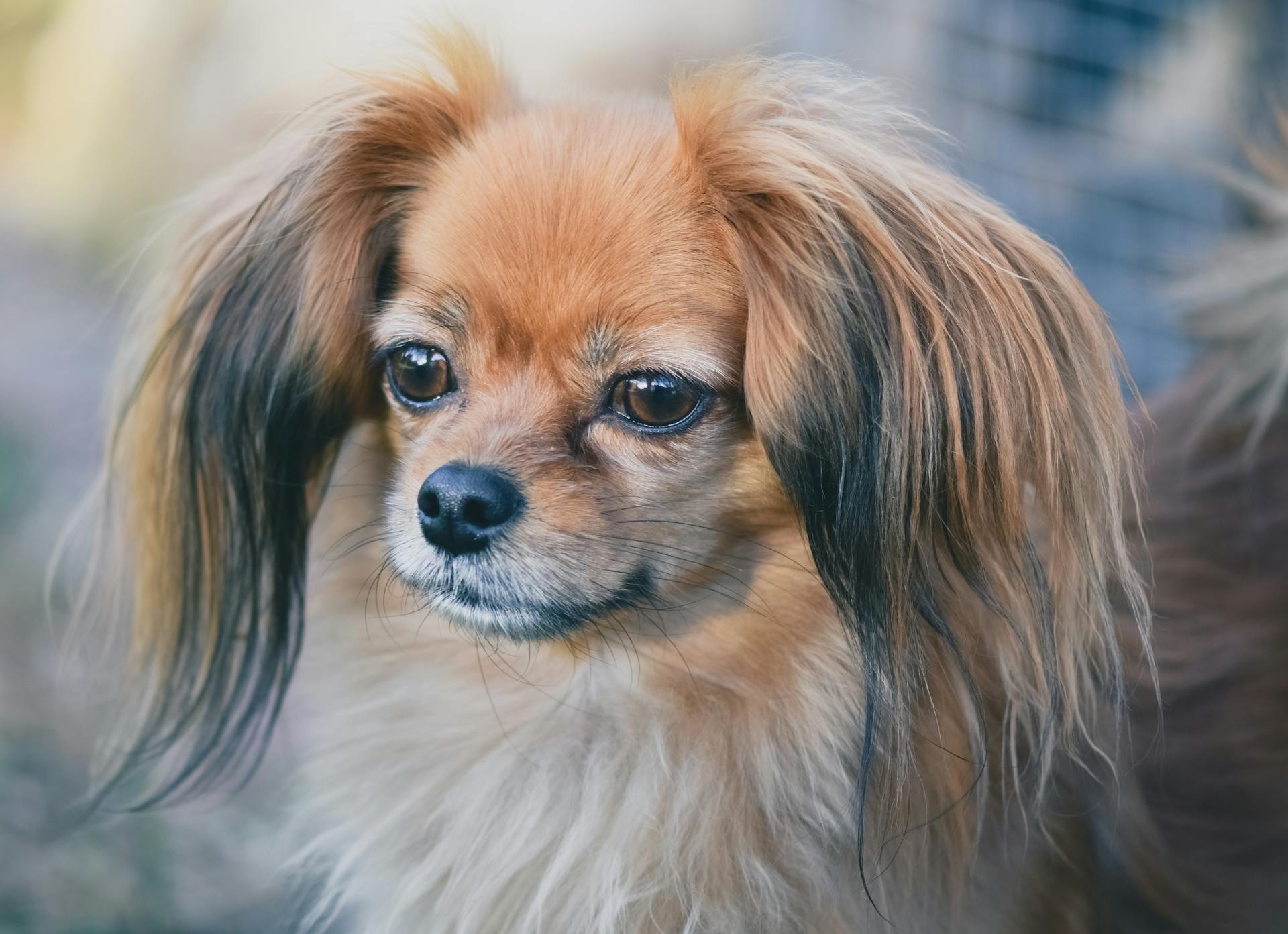
Their training can be slightly difficult, as they have a mind of their own and get bored with repetitious training.
A firm tone of voice is all you need to set them straight when they misbehave, stronger corrections will only backfire and cause them to become stubborn.
Japanese Chin are companion dogs and should not live outdoors or in kennels, they become very attached to their people and many suffer from separation anxiety.
They can be difficult to housetrain but with patience and consistency, you can generally expect them to be house trained by 4 months of age.
Using a harness instead of a collar is highly recommended when walking your Japanese Chin, due to their delicate neck.
Caring for this breed is somewhat low-maintenance, but it's still essential to provide an appropriate amount of exercise for your dog.
Their long, smooth, soft, and glossy coat is relatively easy to maintain compared to other long-haired breeds.
You might enjoy: When to Mate Female Dog
How to Care

Japanese Chin are relatively low-maintenance dogs, but they still require regular exercise to stay happy and healthy.
A daily walk or play session is sufficient to meet their exercise needs, and they're perfect for apartment living due to their low energy level.
Consistency is key when training a Japanese Chin, as they can become bored with repetitive training and develop a stubborn streak if corrections are too harsh.
Be patient and use a firm tone of voice to set them straight, but avoid stronger corrections that might cause them to resist training.
Housetraining can be a challenge, but with patience and consistency, you can expect them to be house-trained by 4 months of age.
Japanese Chin are extremely attached to their people and suffer from separation anxiety, so they shouldn't be left outdoors or in kennels.
Their delicate neck requires special care, so it's best to use a harness instead of a collar when walking them.
On a similar theme: When Do Maltese Dogs Stop Growing
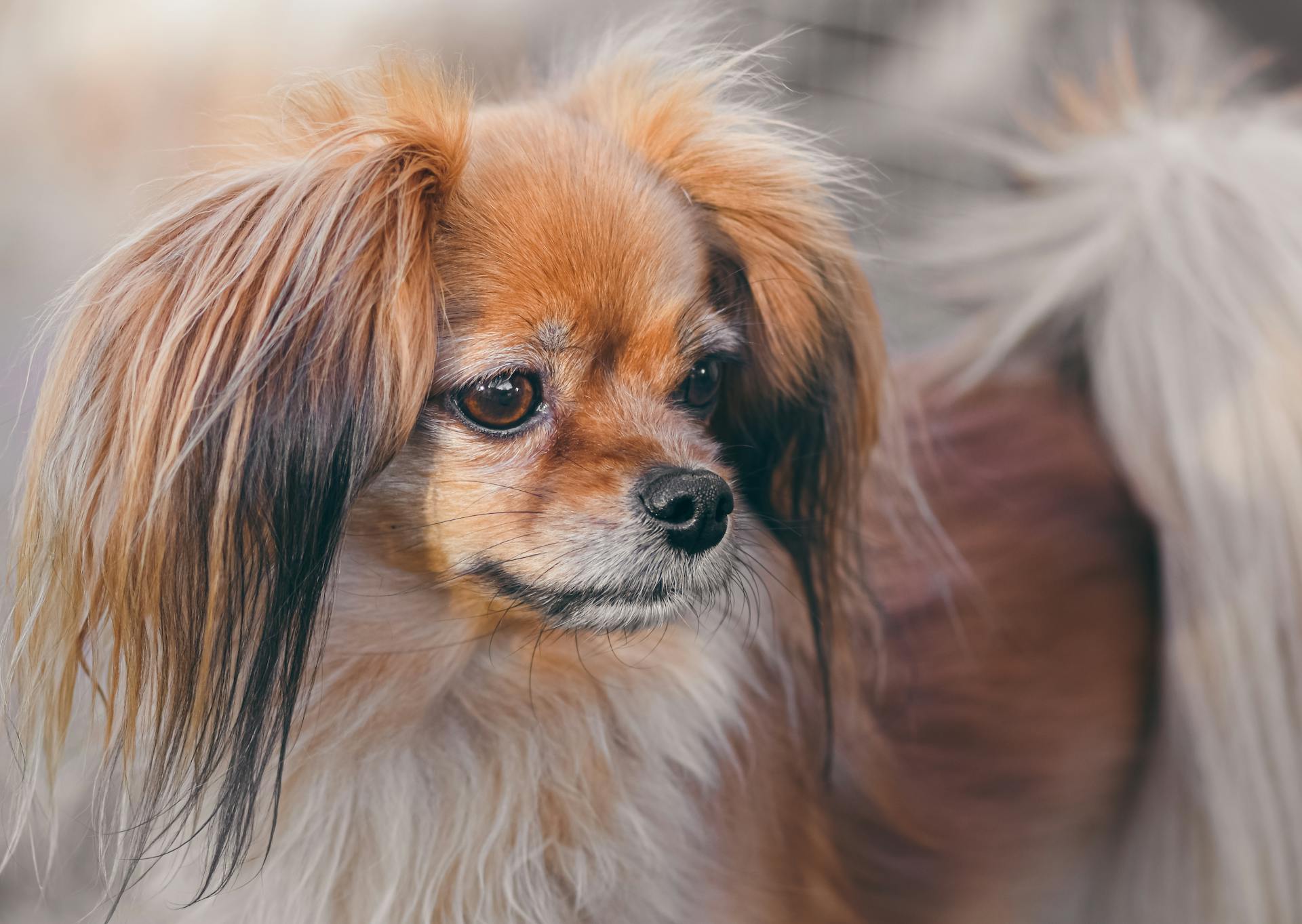
Regular grooming is essential to prevent matting and tangling of their beautiful coat, which sheds moderately and requires weekly brushing.
A gentle shampoo, towel-drying, and pin-brushing can keep their coat looking and smelling great, but be sure to brush their teeth at least two to three times a week to prevent tartar buildup and gum disease.
Trim their nails once or twice a month to prevent painful tears, and check their ears weekly for signs of infection or irritation.
By starting grooming early and making it a positive experience, you'll lay the groundwork for easy veterinary exams and handling when they're an adult.
Frequently Asked Questions
Are Japanese Chin dogs rare?
Japanese Chin dogs are relatively rare, with a limited global population despite their long history of international recognition. Their scarcity makes them a unique and sought-after breed.
Featured Images: pexels.com

